Heavenly Bells
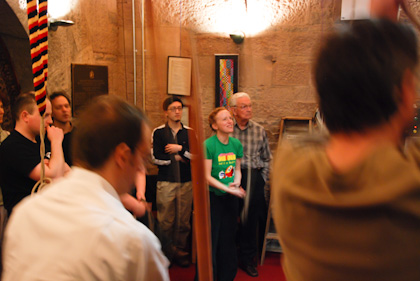 Krystl Hall, who recently took photographs of guests arriving at the New York Academy of Arts’ Tribeca Ball, is also a bell ringer at Trinity Church. She agreed to share photos of the bells, tower, and ringers. (She’s the one in green.)
Krystl Hall, who recently took photographs of guests arriving at the New York Academy of Arts’ Tribeca Ball, is also a bell ringer at Trinity Church. She agreed to share photos of the bells, tower, and ringers. (She’s the one in green.)
I started ringing in 2007. I was on vacation on Cape Cod in the summer of 2006 and needed a beach book. I picked up a stack of mysteries at a library sale—one of which was Dorothy Sayer’s The Nine Tailors. Set in a little village in England, it revolved around a band of bell ringers in the local church. I had never heard of change ringing before that, and I was completely fascinated by the description of it. I thought it was something I would have to seek out the next time I was in England, to hear it for myself. A couple of months later, in October, I was coming out of the subway at Rector Street, and I heard an unusual sound in the air. It was exactly what I had imagined change ringing would sound like—a cascading, evolving series of tones at the intersection of math and music. I followed the sound and it was coming from Trinity Church. They had just installed the bells, and had brought in a band from England to ring the first peal. They had cameras in the bell tower and video monitors in the vestibule, so you could see what the ringers were doing. They were handing out flyers: “Learn to Ring the Bells.” I signed up and they started the first beginner classes the following spring. I’ve been a ringer ever since. We have practice every Wednesday night from 6:30–9:00, and we ring before and after services on Sunday. There’s more information about the bells on Trinity’s website.
••••••••••••••••••••••••••••••••••••••
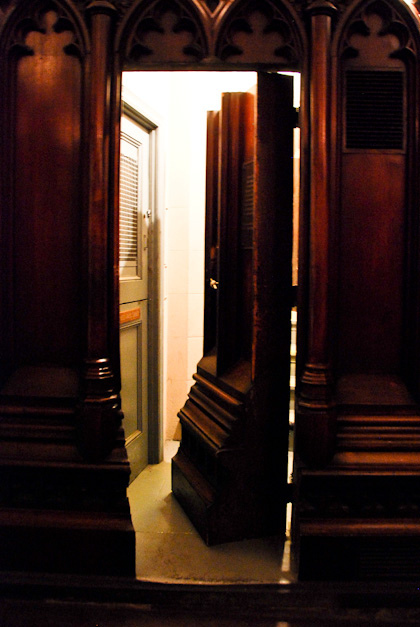 The door to the tower stairs is carved out of the thick paneling in the vestibule. (It’s hard to see when the door is closed.)
The door to the tower stairs is carved out of the thick paneling in the vestibule. (It’s hard to see when the door is closed.)
••••••••••••••••••••••••••••••••••••••
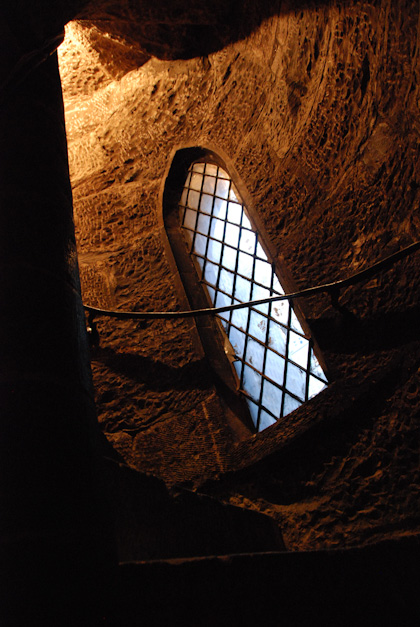 The spiral staircase inside the tower.
The spiral staircase inside the tower.
••••••••••••••••••••••••••••••••••••••
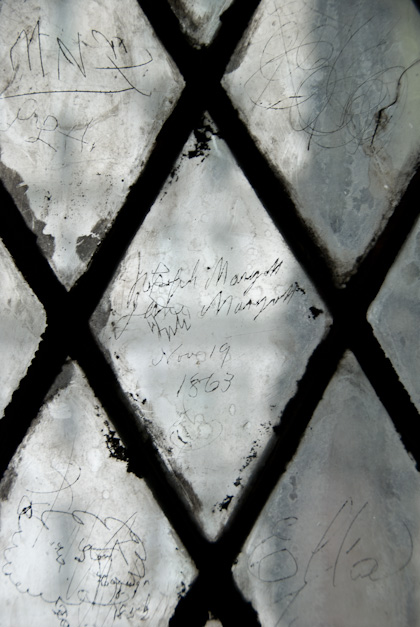 A bit of 19th-century graffiti on the windows in the tower stairwell.
A bit of 19th-century graffiti on the windows in the tower stairwell.
••••••••••••••••••••••••••••••••••••••
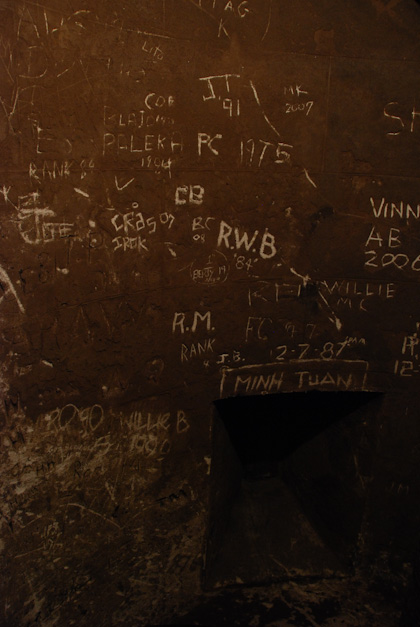 ••••••••••••••••••••••••••••••••••••••
••••••••••••••••••••••••••••••••••••••
A visitor gets a beginner’s lesson.
••••••••••••••••••••••••••••••••••••••
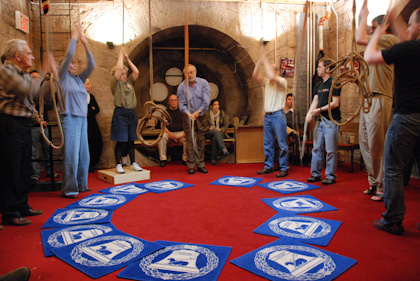 ••••••••••••••••••••••••••••••••••••••
••••••••••••••••••••••••••••••••••••••
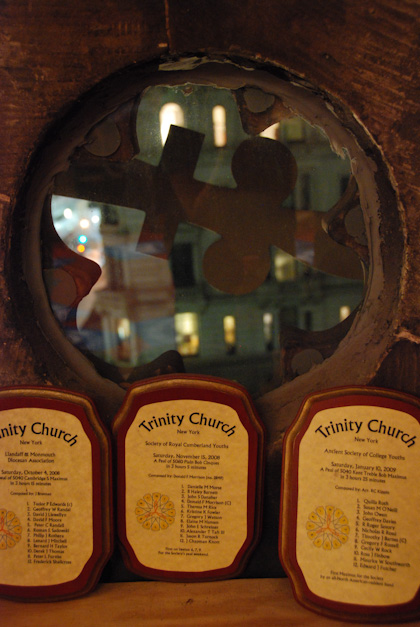 A view through one of the windows that make up the clock face on south side of the bell tower. The club shape seen through the window is the hour hand of the clock. The small plaques commemorate peals that have been rung in the tower.
A view through one of the windows that make up the clock face on south side of the bell tower. The club shape seen through the window is the hour hand of the clock. The small plaques commemorate peals that have been rung in the tower.
••••••••••••••••••••••••••••••••••••••
••••••••••••••••••••••••••••••••••••••
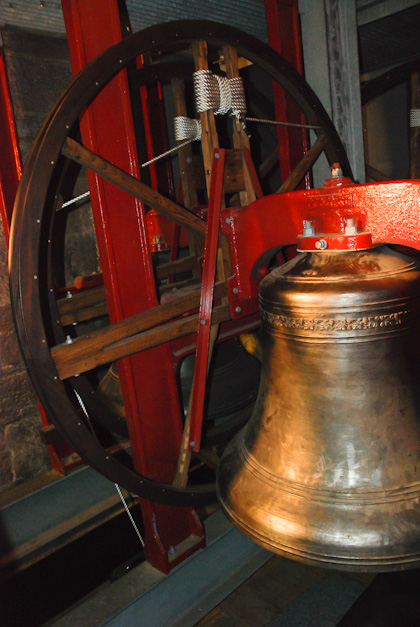 The rope runs through a groove in the wheel on which the bell is mounted. When the rope is pulled, the wheel turns, bringing the bell with it. the clapper falls against the side and the bell sounds. Momentum carries it around in the other direction as gravity pulls it back down. The ringer controls the speed at which the bell rings by pulling harder or softer, putting more or less momentum into the wheel.
The rope runs through a groove in the wheel on which the bell is mounted. When the rope is pulled, the wheel turns, bringing the bell with it. the clapper falls against the side and the bell sounds. Momentum carries it around in the other direction as gravity pulls it back down. The ringer controls the speed at which the bell rings by pulling harder or softer, putting more or less momentum into the wheel.
••••••••••••••••••••••••••••••••••••••
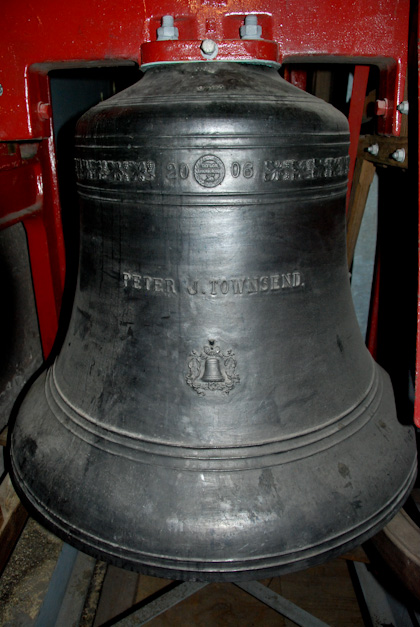 ••••••••••••••••••••••••••••••••••••••
••••••••••••••••••••••••••••••••••••••
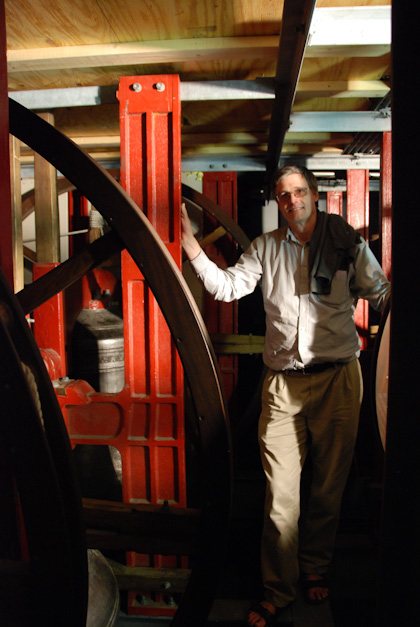 Steeplekeeper Greg Russell in the belfry.
Steeplekeeper Greg Russell in the belfry.
••••••••••••••••••••••••••••••••••••••
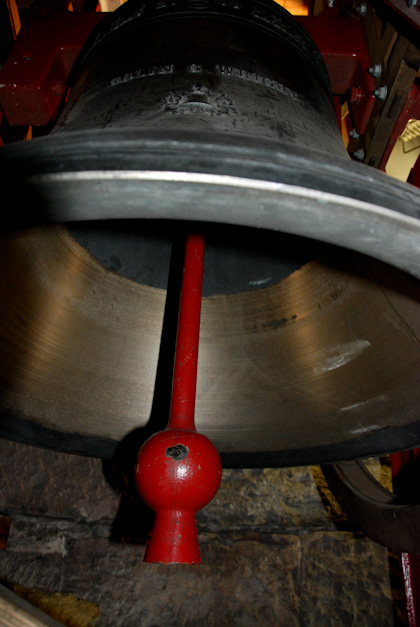 A bell from below. Even the clappers are incredibly heavy.
A bell from below. Even the clappers are incredibly heavy.
••••••••••••••••••••••••••••••••••••••
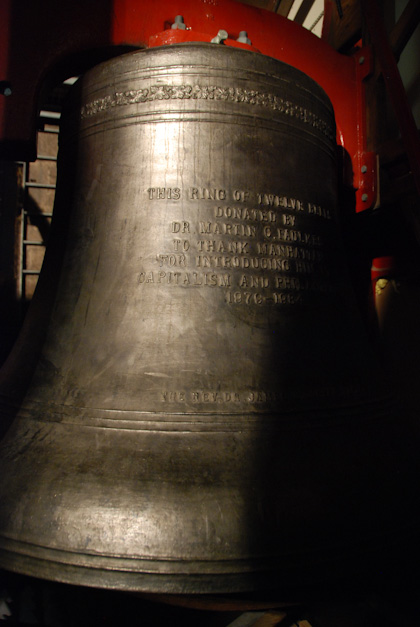 The largest bell in the ring, the tenor weighs 2,700 pounds. The inscription reads: “This ring of twelve bells donated by Dr. Martin C. Faulkes to thank Manhattan for introducing him to capitalism and philanthropy 1979–1984.”
The largest bell in the ring, the tenor weighs 2,700 pounds. The inscription reads: “This ring of twelve bells donated by Dr. Martin C. Faulkes to thank Manhattan for introducing him to capitalism and philanthropy 1979–1984.”
••••••••••••••••••••••••••••••••••••••
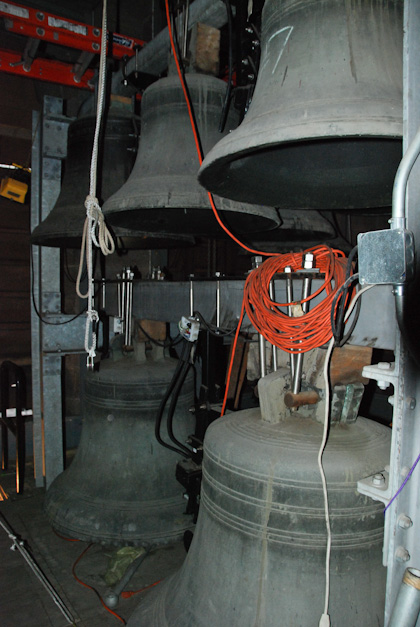 The chimes that ring the time—mechanically rung every 15 minutes—live one level up from the change ringing bells.
The chimes that ring the time—mechanically rung every 15 minutes—live one level up from the change ringing bells.
••••••••••••••••••••••••••••••••••••••
 The choir is often practicing on Wednesday nights, and it’s wonderful to be leaving after ringing and to walk through the darkened church while listening to them. When I took this picture, though, there was an orchestra as well, and they were practicing St. Matthew’s Passion, for Good Friday. Magical.
The choir is often practicing on Wednesday nights, and it’s wonderful to be leaving after ringing and to walk through the darkened church while listening to them. When I took this picture, though, there was an orchestra as well, and they were practicing St. Matthew’s Passion, for Good Friday. Magical.
••••••••••••••••••••••••••••••••••••••
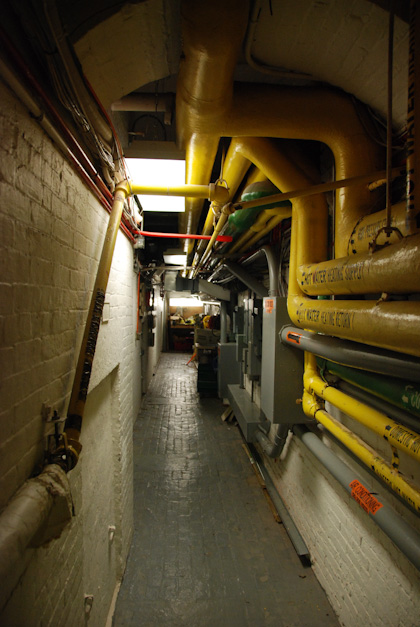 We go out through the basement when the church is locked at night. This is a hallway off the boiler room. There are crypts in the basement, so this is nice and creepy.
We go out through the basement when the church is locked at night. This is a hallway off the boiler room. There are crypts in the basement, so this is nice and creepy.
••••••••••••••••••••••••••••••••••••••
On the way to the boiler room under Trinity Church
••••••••••••••••••••••••••••••••••••••
A sign in the boiler room
••••••••••••••••••••••••••••••••••••••
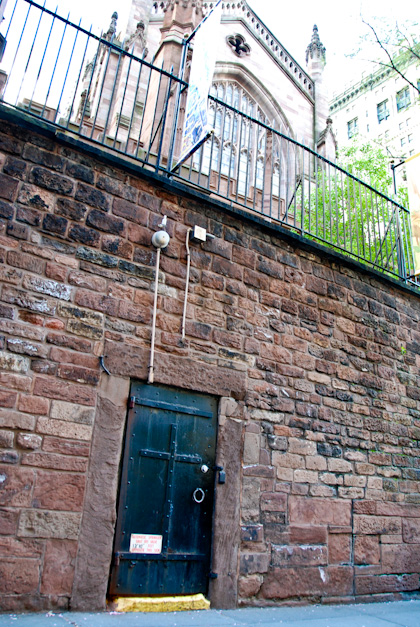 One of the great things about being a bell ringer is the opportunity to use this door. When the church is locked up at night, we leave through here after bell practice. We call it the dungeon door, although it really just leads to the boiler room of the church. There are also crypts in there, though, and the wall is the retaining wall of trinity’s graveyard. I had admired this door for years before I had a chance to pass through it.
One of the great things about being a bell ringer is the opportunity to use this door. When the church is locked up at night, we leave through here after bell practice. We call it the dungeon door, although it really just leads to the boiler room of the church. There are also crypts in there, though, and the wall is the retaining wall of trinity’s graveyard. I had admired this door for years before I had a chance to pass through it.







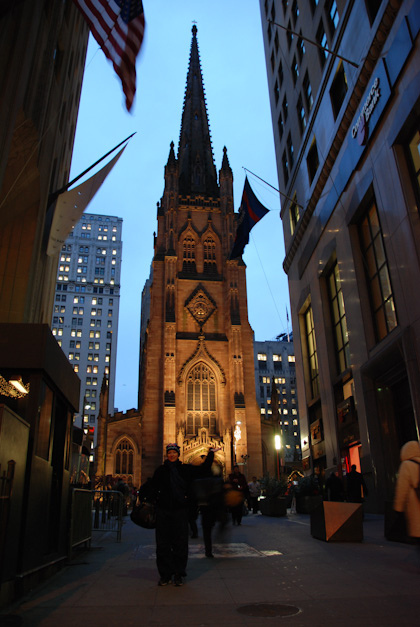
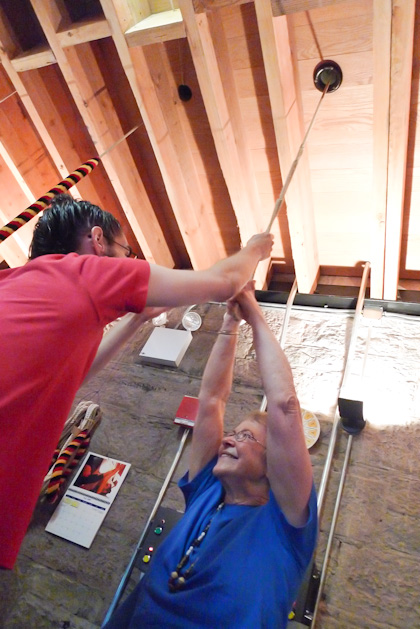
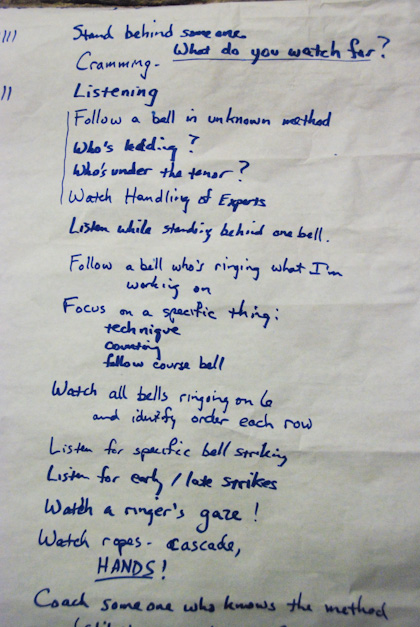

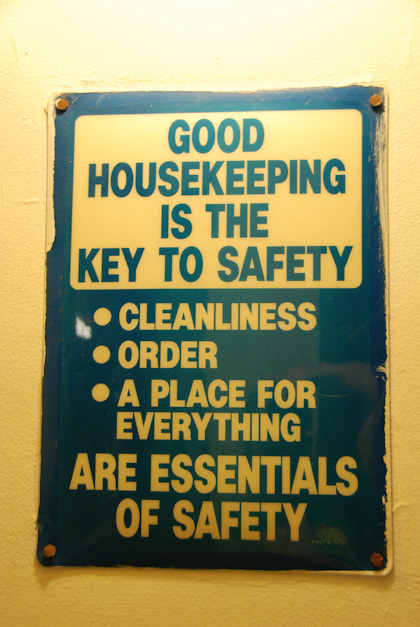







Thanks Krystl. Thanks Erik. Wonderful piece.
Really terrific content. Thanks!
Great article. Terrific pictures.
Some of the most beautiful, engaging, and mysterious pictures of Trinity and the bell-ringing tower I’ve seen. Bravo, Krystl!! Stunning!
Fantastic, Krystl! Thanks very much for sharing the wonderful photos and your personal ringing story.
Great photos. Fascinating
I love lower Manhatten and have visited many times. Telling a friend of mine about it he told me that did change bell ringing at Trinity! I was shocked. He has actually started a very small change bell choir with our choir The New England Chamber Choir! Small but mightly. I was blessed to hear some of the Trinity bells on the 4th of July a couple of years ago. Fabulous! Thank you!
So glad you did this feature. I once saw someone going into that “secret” door and wondered what was in there. And the west wall (in the last photo) is one of the great evocative features of downtown.